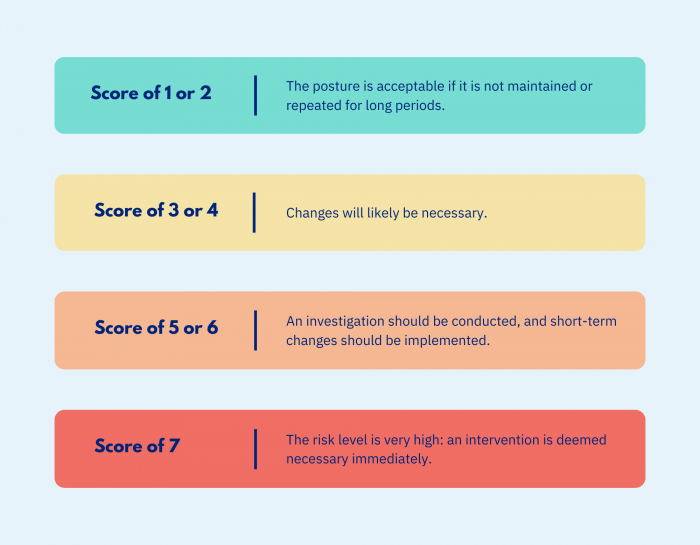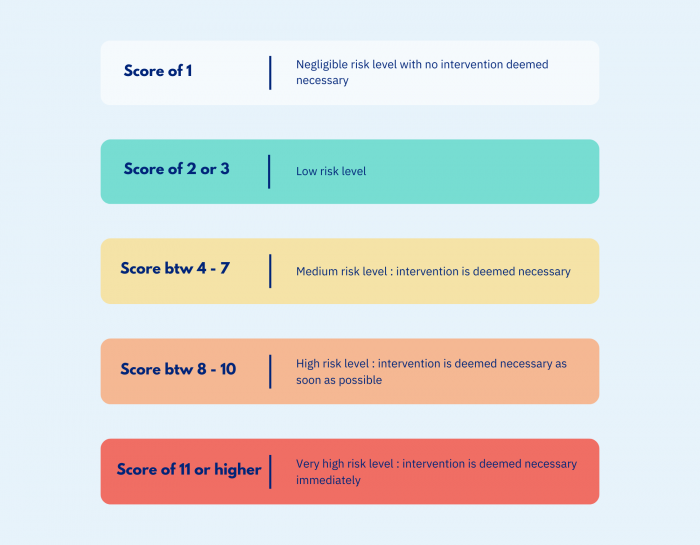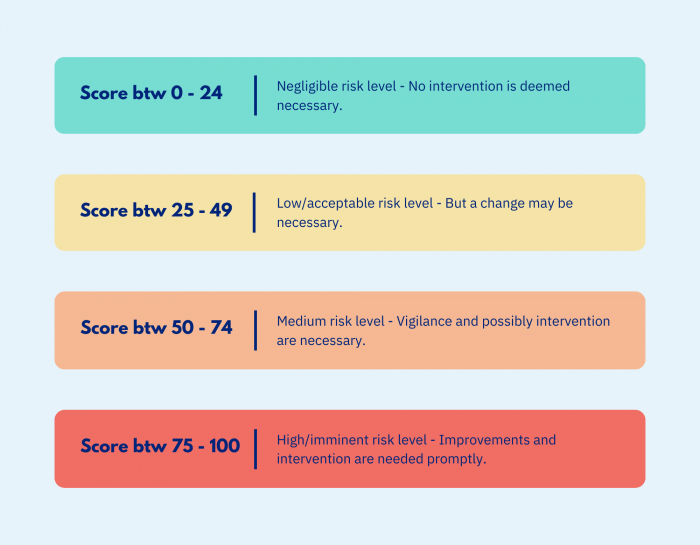RULA and REBA Grids : What are we talking about ?
RULA and REBA grids are a set of tools designed to quantify the level of strain and risk associated with a work activity. These assessment methods are mainly used by ergonomists to evaluate the physical risk of musculoskeletal disorders (MSDs) at a given moment. They are relatively easy to use so that they can be made available to a wide range of health prevention professionals.
Let’s take a closer look !
RULA : Origins and Utilization
Origins:
The RULA rating method (Rapid Upper Limb Assessment) was developed in the 1990s by McAtamney & Corlett (1993). This method enables the analysis of individual workers’ exposure to risk factors that could lead to the development of physical disorders in the upper limbs related to work.
The creation of this method stemmed from investigations conducted in the textile industry, where task assessments were implemented for various positions (working on sewing machines, stapling, visual inspections, packaging, etc.).
Utilization:
RULA is an evaluation method that determines the risks of work postures observed on the upper body and evaluates them with an overall score calculated on a scale of 1 to 7.

The RULA grid does not consider other MSD risk factors (individual, organizational, psychosocial, and environmental). However, it does consider aggravating criteria such as “effort,” which adds to the postural criteria: categories of 5kg, 10kg, and 15kg.
The scoring is done by assigning a score for each joint based on its positions. The RULA score is established based on 4 action levels that provide final indications on the necessity of implementing an intervention.
Furthermore, RULA meets the assessment requirements of the European Community Directive (90/270/EEC) on minimum safety and health requirements for work.
REBA : Origins and Utilization
Origins:
REBA (Rapid Entire Body Assessment) is an analysis tool used to evaluate constraints based on joint angles. This grid was developed in 2000 by Hignett and McAtamney.
This method was developed to address a practical need, specifically designed to be sensitive to unpredictable work postures (such as contingencies) found in healthcare and other service sectors. Created by a team of ergonomists, physiotherapists, occupational therapists, and nurses, they individually collected and coded over 600 postural examples to produce a new tool integrating upper limb positions.
REBA complements the research conducted to establish the RULA score in the 1990s.
Utilization:
Although like the RULA grid, the REBA grid focuses on the entire body. It provides an objective analysis of the constraints related to tasks performed by the operator and is calculated on a scale of 1 to 15.
The body parts analyzed include wrists, forearms, elbows, shoulders, neck, trunk, back, legs, and knees.

The REBA method uses a scoring grid to analyze posture assessment, encompassing static, dynamic, changing, or unstable positions, much like RULA.
The REBA score provides a postural risk score, allowing for the quantification of the posture’s risk level. In addition to considering aggravating criteria such as “effort” (categories of 5kg, 10kg, and 15kg), REBA also considers the quality of grip.
Like RULA, the REBA grid primarily focuses on work postures and does not consider other risk factors (individual, organizational, psychosocial, and environmental). It is also not recommended for manual handling analysis.
Kimea, a comprehensive scoring grid
Several indicators of MSD risks are integrated into Kimea Cloud, allowing for automated calculation of physical risk scores. The grids used are the reference grids in ergonomics: RULA, REBA, NFX 35-109, and NIOSH.
The Kimea score is presented as a weighted sum of the time spent by the operator according to a risk level (red, orange, yellow, and green zones). For example, a score belonging to a red risk level will have a higher weighting than a score in the yellow zone. The Kimea score is structured on a scale of 100 points as follows :

Each limb/joint will be analyzed and scored according to the degree of risk for the operator. You can also visualize the parts of the body that interest you individually and according to several levels of analysis.
Why have we brought together all these analysis methods?
Simply put, to offer you a more precise and tailored result for all types of workstations. We also wanted to measure the exposure time at each risk level.
Conclusion
The REBA and RULA grids are widely used in the field of ergonomics. They provide a foundation and establish a scientific framework for professional practices.
While these grids provide initial indications, they do not offer a comprehensive view of the MSD risk evolution during the task. Indeed, these grids only provide the intensity of the risk for the posture and not the duration during which the operator is exposed to the risk. This is why Kimea was created.
Sources :
- RULA: a survey method for the investigation of work-related upper limb disorders – https://www.sciencedirect.com/science/article/abs/pii/000368709390080S
- Rapid entire body assessment (REBA) – https://pubmed.ncbi.nlm.nih.gov/10711982/
